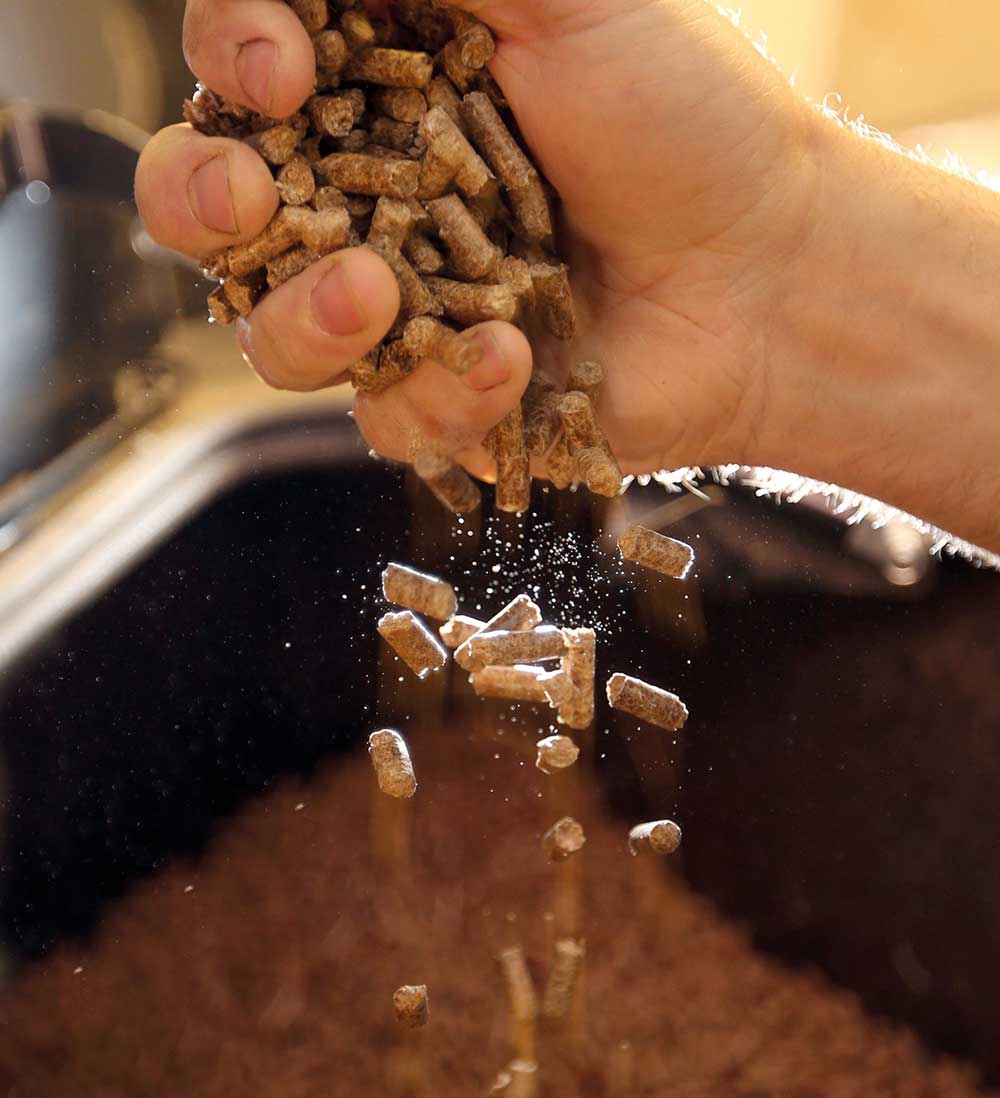Biomass is organic matter used as a fuel. It covers everything from fish oil and bone meal to wood and energy crops; for your home it’s likely to mean a log, wood chip or a wood pellet burning boiler or stove as other fuel sources are not yet feasible on a small scale.
Almost everyone is accustomed to burning wood or peat on an open fire to produce heat. In its most basic form this is biomass combustion. We all know that it takes time to light a fire, for it to become established, to burn well and to produce good heat. To do this it needs a regular supply of good quality, dry wood and adequate air for combustion.
If the wood is too damp or the draught is insufficient it will not burn well. Alternatively, if there is too much draught all the heat goes up the chimney! Similarly, once you stop fuelling a fire, it takes time for the fire to die down and eventually go out. These are the basic principles applicable to all biomass combustion and should be borne in mind when designing any system.
Sizing an installation
The regulations are many and complex so professional input is necessary; in both NI and ROI a HETAS registered installer will ensure safe installation. Also make sure the equipment and final installation is CE marked. There is no infallible rule of thumb for sizing but generally the start point is to calculate the heat losses from that room and ensure that the heat output from the appliance to the room (normally quoted in kW by the supplier) does not exceed the calculated heat losses.
Any design of stove/cooker will heat the room in which it is located and, if the heat output to the room is too high, the room will become unusable when the appliance is in operation. Room heat loss calculators are available online for rough calculations, but, for modern houses, accurate heat and ventilation losses should be established by a professional. A stove with back boiler may need to dump heat and it may be possible to include a thermal store for this (buffer tank) but this will increase capital costs substantially.
In a well insulated house the design heat losses may well be so low that you cannot source an appliance with a back boiler with a sufficiently low room output. Sizing can be tricky for a standalone stove too but, depending on the configuration of the building, the heat may be able to circulate around the house. An alternative which will still give you a live flame is to install a gas or other low output stove that emits very little heat.
Once the room output has been calculated, consider the other uses. Distribution losses and, where relevant, hot water demand must be added to the design heat load of the building or room.
Biomass vs. other boilers
Biomass boilers take time to light, reach an efficient burn rate and to extinguish themselves. During all of this time they produce heat. Thus, they cannot modulate their heat output in response to changing heat loads in the same way as a modern modulating gas boiler (a modern hi/low oil boiler does modulate but not as well as gas). The level of automation of biomass systems is directly relevant to the type of fuel used. In general, the more fluid the energy source (electricity being the optimum), the more automatic the system can become.
A heat pump, for example, requires only one ‘fuel’, electricity, normally delivered automatically from a mains connection. In contrast, a log boiler requires both wood and electricity and the wood must be handled manually. Even automatic pellet boilers require some level of manual intervention, if only to dispose of the ash. In general operation, thermal storage (a buffer tank) allows the boiler to operate over a smaller range and reduces the requirement for turndown so a 30 per cent reduction over conventional (gas or oil) design sizing should be possible with a biomass boiler.
The practical limits will be dictated by the load pattern, the response time of the heating system and the thermal response of the building.
Fuel
Dry timber is crucial for several reasons. If wet timber is burnt, considerable energy is used to drive off moisture, reducing the efficiency of the process, and volatile oils which would normally burn will condense as they cool in the chimney, depositing a layer of tar. When the wood dries out, some fly ash will inevitably be released and stick to the tar in the chimney.
Ultimately, the chimney will become constricted reducing the available combustion air and it could eventually lead to a chimney fire. For 20 per cent moisture content logs, approximately 5.5 times the volume of oil will be required for the same energy content. So, if you burn 1,500 litres of oil a year (≈1.5 m3 ), you will require about 8.25m3 of wood. The equivalent of 1,000 litres of oil in wood pellets is 3m3 and for 30 per cent moisture content woodchip you would need almost 11.5m3.
These are considerable volumes and, even if you are producing your own wood chip, will require transport, mechanical loading and storage. All of these must be carefully considered in evaluating a scheme. If pellets are exposed to damp, they soon take on the consistency of damp porridge oats and become permanently unusable. Similarly, wet wood chips will, in time, start to decompose creating heat and, in extreme cases, have been known to spontaneously combust!
The method of collection and transfer from the store to the boiler must also be decided upon. This may be swept arm and auger, gravity to auger or vacuum fed.
Multifuel versus single fuel stoves
Multi fuel stoves are available for burning either logs or coal but, by definition, cannot be optimised for either fuel. Note that burning logs with coal at the same time in multi fuel stoves can produce sulphurous acids that can corrode metal surfaces and reduce appliance lifetime. Pellets have the advantage of enabling various levels of automation; the lighting, combustion and extinguishing sequence can be timed to occur automatically, providing sufficient fuel is available.
Some burner designs deliver more reliable automation than others. Most pellet fed appliances have a combustion air fan to control the burn rate; this gives you more choice in terms of where to locate the appliance. Log burners are unsuitable for installations with inadequate draught or down draught. Pellet stoves can often be used in these instances due to the forced draught from the combustion air fan.
Pellet stoves often include fan assisted room heat output for rapid space heating and there are models designed to duct blow warm air to other rooms. Pellet fed appliances with back boilers normally require some daily cleaning and a more thorough weekly clean.
Health & Safety
All biomass systems can be dangerous if incorrectly designed, installed or operated. An important point to understand is that all biomass burners require an adequate supply of air to enable
combustion. In today’s era of airtight building design, (compounded by the fact that mechanical ventilation systems can create negative pressure in a room with a stove), a dedicated airtight
combustion air supply routed directly from the appliance to the exterior is necessary, even in refurbished buildings.
Without an adequate air supply dangerous levels of carbon monoxide can build up and, ultimately, cause death. Regular maintenance will ensure the air supply pathways are kept clear for safe combustion. Water must be able to pass through boilers at all times to remove the heat from the fire. Should the water stagnate it will ultimately turn to steam, whose volume is approximately 1,600 times that of water (depending on pressure).
To stop overheating and inefficient fuel consumption an effective method of protecting a boiler in the event of a power outage or mechanical breakdown, which can relieve the pressure and heat, is essential. The means of protection for all types of log, chip and pellet boilers should be specified by the system designer on a case by case basis.









